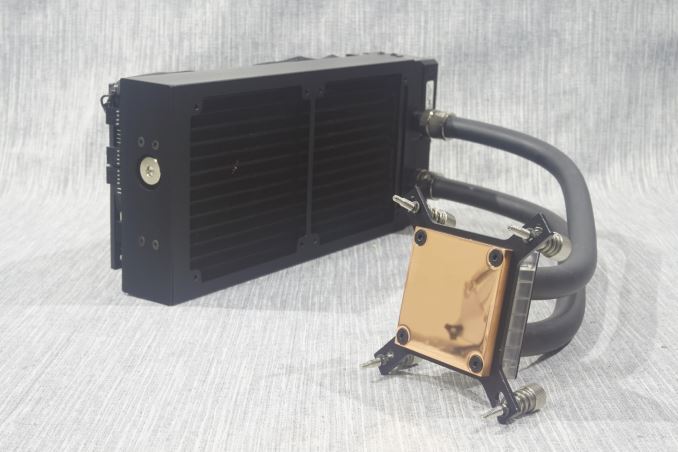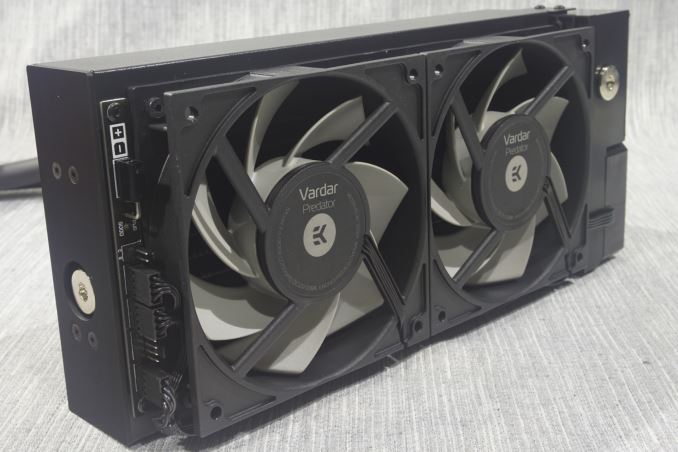The EKWB EK-XLC Predator 240 Liquid Cooler Review
by E. Fylladitakis on December 15, 2015 9:00 AM EST- Posted in
- Cases/Cooling/PSUs
- AIO
- Water Cooling
- Liquid Cooling
- EKWB
Conclusion
According to EKWB, they wanted the EK-XLC Predator 240 to be a design focused on the "enthusiast level AIO cooler" segment, made of high performance components that would mimic the performance of a custom liquid cooling system. While we cannot claim that it could really rival a custom liquid cooling system carefully designed for maximum performance, the EK-XLC Predator 240 does perform very well in comparison to other AIO coolers. Its thermal performance does not look stellar at first, but the superiority of the EK-XLC Predator 240 becomes apparent when the noise figures are compared. The noiseless pump is, in our opinion, the greatest performance advantage of the EK-XLC Predator 240, as whiny pumps are a common and large issue for the majority of AIO coolers. We feel that the EK-XLC Predator 240 will be loved by those who want the best possible thermal performance at low/inaudible noise levels.
EKWB is particularly proud about the quality and the expandability of the EK-XLC Predator 240. Our examination revealed that it is a high quality product, well designed and assembled, made of good parts and a particularly good high performance pump. However, it is not impeccable. There are quality flaws, such as the draining port next to the pump - the threads of this are on the plastic frame and can be destroyed very easily by the high torque of the tool. The company needs to clearly inform the user that this port is very sensitive and it should be tightened very gently. Also, if the water block is disassembled, as the company suggests it should for cleaning, it is not easy to reseal it without proper tools and equipment. If it is just put together again, without treating the flange and tightening the screws with a specific torque and in rotation, it is very likely that it will start leaking.
Regarding the expandability of the system, that is a rather grey area. It is always good to have an upgradable setup but, the truth is, there is no reason for someone who considers future upgrades not to go for a custom liquid cooling setup to begin with. A custom cooling setup would perform just as well, if not better, and provide maximum versatility for about the same cost. If the EK-XLC Predator 240 is to be drained and disassembled, the lack of a proper reservoir makes it even more difficult to work with. It appears more sensible to deal with the added complexity of designing and building a custom liquid cooling system now than having to deal with disassembling and putting back together the EK-XLC Predator 240 in the future.
It appears that EKWB is trying to fit too many eggs into one basket with the EK-XLC Predator 240. They want it to be appealing to the amateur who wants a simple but high performance cooling solution, to the enthusiast who wants top grade hardware and to the expert that wants to tweak and upgrade it. In our opinion, EKWB is failing to satisfy the bulk of the AIO cooler market, which consists of casual users who want something better than air cooling but simple enough to install and maintain, all without breaking the bank. The EK-XLC Predator 240 is clearly aimed towards a portion of enthusiasts only: those who are not going to back down once they gaze on the price tag. This is also ascertained by the instructions and suggestions found in the manual, which are definitely not for amateurs. The only problem is that such advanced users would have no problem buying individual parts and designing their own liquid cooling system.
In summary, EKWB effectively designed a high quality AIO liquid cooler that can offer relatively good thermal performance at very low noise levels. It also is expandable, if the user ever decides to divulge deeper in the world of advanced cooling. The primary issue here is, and the company is not hiding it at all, that the EK-XLC Predator 240 is considerably more expensive than most other AIO liquid coolers. The current retail price of the EK-XLC Predator 240 matches its MSRP as well, selling for $199 including shipping. This is nearly twice as expensive as its main competitors, such as the Corsair H100i GTX ($110) and the SilverStone Tundra TD02 ($100). It is up to each individual user to decide whether the slightly better overall performance and promise of expandability is worth such a price.












36 Comments
View All Comments
zeeBomb - Tuesday, December 15, 2015 - link
Awesome coolerHollyDOL - Tuesday, December 15, 2015 - link
So, with a SkyLake, you can cool at about 10°C above ambient at 35dB? That's definitely NOT BAD outcome.DanNeely - Tuesday, December 15, 2015 - link
Almost certainly not; you'll see temps significantly higher. The heater blocks E. Fylladitakis uses to simulate a thermal load that's more stable than you can get with a real CPU have a major failing that makes them impossible to equate to performance on an actual system useless. The temperature reported on your CPU comes from a handful of tiny hotspots on the die that do a lot more work, consume the majority of the power, and are much hotter than the rest of the die.The hot spots are why, although TDPs have stayed more or less fixed on desktop chips since the Core 2 era, actual CPU temperatures have been on a steady upward swing. Each new process shrinks the bits of the CPU that do the actual calculations and generate the largest part of the heat into a smaller chunk of the die. The extra die space gets filled up with cache which doesn't have hot spots or GPU space that because they have large numbers of tiny cores instead of a few big ones can spread out the heat a lot better.
DanNeely - Tuesday, December 15, 2015 - link
The CPU waterblock in this kit looks a lot like the EK Supremacy EVO in my custom loop. That block is explicitly intended to be taken apart and reassembled prior to installation (it has several parts intended to control water flow that are intended to be swapped for different CPU models), Unless you're an idiot who can't be bothered to read directions it was strait forward to follow the printed instructions to open it up, swap in the parts for my CPU and then put it back together.That experience also has me concerned about your testing methodologies results will correlate to real world relative performance. The intent of adjusting all of those fiddly bits in the block was to direct the flow to maximize cooling of the hottest parts of each specific chip; something that can't be captured by a simple resistive heating block. Testing I saw a few people who were curious if it really mattered showed spreads between different internal configurations of several degrees; comparable to the total spreads you're seeing among decent water cooler kits.
londiste - Tuesday, December 15, 2015 - link
The extra header on the fan controller is with Predator 360 in mind.tabascosauz - Tuesday, December 15, 2015 - link
This entire article was written with the assumption that the only benefit offered by the Predator is its expandability, as with the H220-X. That's not the point of the kit.The point is that when you buy the Predator, you are basically buying EK products, with the added benefit that someone has already assembled the parts for you. The CPU block is the same Supremacy (EVO?) block that you get off of the market for your custom loop, and so are the Vardar F4 fans and the Coolstream PE rad.
It's not meant to be an end to the endless CoolIT and Asetek AIOs on the market. People aren't going to buy it in comparison to the H100i. They'll buy because it's a nice place to start one's future custom loop system.
tabascosauz - Tuesday, December 15, 2015 - link
I suppose I'm expecting a bit too much from AT reviewers these days. Clearly, they don't do even the slightest bit of reading before starting their reviewers. Block appears to be small and doesn't have a pump like other AIOs? A bit of digging even into EK's product page for the 240 would reveal that the block is a Supremacy MX and obviously wouldn't have a pump integrated into it, like all proper watercooling CPU blocks (exception made to the Apogee Drive II).forgot2yield28 - Tuesday, December 15, 2015 - link
Your first sentence states that the point is not expandability, and yet your last sentence states that it will be purchased as a start to a future custom loop--ie users will add and modify it, in other words, expanding it. Did I miss something?tabascosauz - Tuesday, December 15, 2015 - link
Ach, never mind. The review is adequate.owan - Wednesday, December 16, 2015 - link
Yea, you missed the fact that its *not only* expandability. There are other products that offer expandability, but EK's offers expandability and quality components you'd probably be happy re-using.